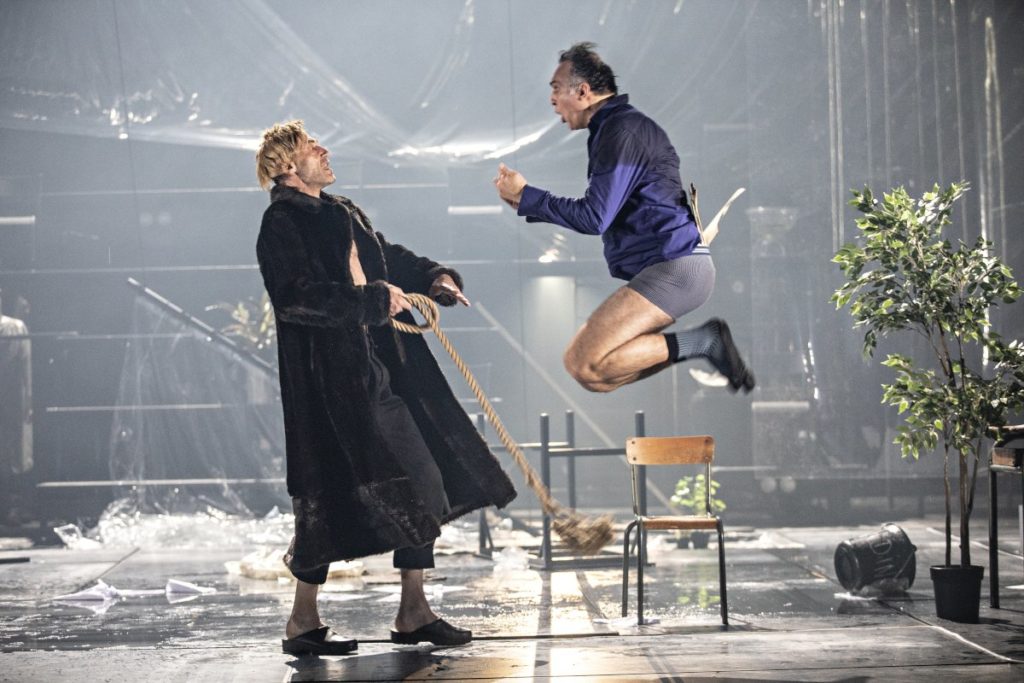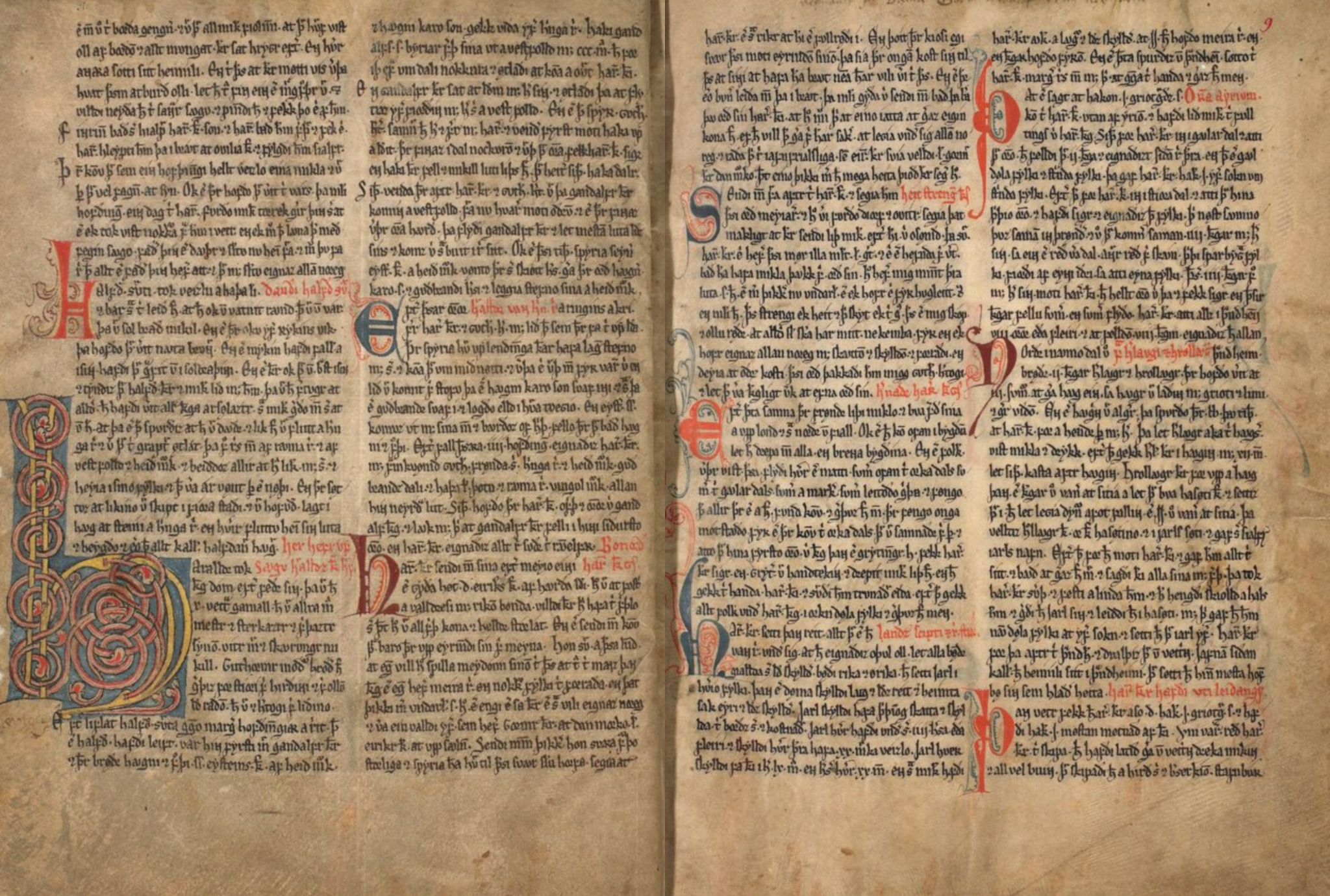It appears to be a euphemism to say that Ibsen maintained a complex relationship with his home country throughout his life. He hated Norway just as much as he loved it[1]. Although he “could not feel more homeless than up there [in Norway][2]”, almost all of his plays are set in Norway. However, the dramatist did not simply write about his country as a whole: he put a special emphasis on the “North of the North”[3].
His former pseudonym shows to what extent he was fascinated by the northern part of Norway from the beginning of his career. By calling himself Brynjolf Bjarme, he made a clear reference to Bjarmaland, the so-called extreme north in the medieval sagas[4]. Those Old Norse texts became a remarkable source of inspiration for him as soon as he could read them, thanks to the translations of N. M. Petersen:
“Fandt jeg i rigt mål i de islandske sagaer, hvad jeg behøvede som menneskelig iklædning for […] de tanker der foresvævede mig.”
“In the Icelandic sagas, I found in abundance what I needed to give a shape […] to the ideas that obsessed me”. Ibsen’s words in 1883 in the preface of the second edition of Gildet Paa Solhaug (1855) in 1883, p. 102.
In those medieval stories, the inhabitants of the Scandinavian North are the Finnar. They live in the Finnmǫrk, a larger area than the modern-day Norwegian Finnmark[5]. The name given to their land says a lot about the way the Icelanders perceived the Finnar. Finn refers to the Finnar while mǫrk to the forest as well as to the limits. It implies that the Finnar were considered as residents of Norway on the one hand, and on the other as outsiders living at the farthest periphery of the country. Far from the center in terms of geography, the Finnar were also far away from civilization.
The Same Perception of the Northern Inhabitants Through Centuries
The Norwegians‘ perception of the Sámi (the modern name for the Finnar) and of the inhabitants of the northern counties — Troms, Finnmark and Nordland — did not evolve that much in the 19th century. Arne Garborg thought they were so outlandish that they must belong to another race[6], while Bjørnstjerne Bjørnson argued that people exposed to the nature of the North could experience the same adventures as the characters in the sagas[7].
Strange as this assumption may appear to us, Ibsen seemed to agree with it. In one quarter of his plays, the main characters have strong connections to the North, and their portrayal was undoubtedly to a certain degree influenced by Ibsen’s contemporaries, but mainly by his readings of the sagas. Ibsen’s real knowledge of this part of Norway was limited because he had not traveled further north than Trondheim before 1891[8]. Nevertheless, this did not stop him from writing about it.

Let’s focus on two interesting Ibsenian characters.
Tomas Stockmann from En folkefiende (An Enemy of the people, 1882) is a man who has worked in Nordland for a long time and has returned to his southern home town.
Rebekka West from Rosmersholm (1886) was born and raised in Finnmark and she is living on the west coast of Norway.
In the two plays, Ibsen underlines their strangeness by openly alluding to their “northern” character traits and appearance. They are the fruit of the primitive and uncivilized northern wilderness, and Ibsen, like the writers of the sagas, emphasizes their connection with the nature of the place they come from.
A map of Norway from mapsopensource.com.
Tempestuous Characters
The Finnar from the sagas are well-known for their ability to control nature and its phenomena to serve their own interests[9]. In Ólafs saga Helga they use their magical powers to create a hurricane in order to sink the Norwegian fleet of king Ólaf (ch. 9).
While the Finnar are able to raise storms, Rebekka in Rosmersholm literally embodies a wind of change. When she first appears on stage, Mrs. Helseth asks her: “Trækker det ikke svært, dér frøkenen sidder?[10]” (p. 327) because she is sitting in the draft without it bothering her. She is herself a representation of the storm coming down on Rosmer’s manor, as if she had brought the harsh climate of the North with her. For Georg Brandes, Rebekka is the personification of Nordland, because she is controlled by “violent uncontrolled temperaments[11]” like the place from where she came.
Indeed, Kroll, who wants to warn Rosmer that Rebekka is a bad influence on him, states
“Du aner ikke, hvor overhændigt uvejret vil komme over dig” (p. 396)
“You have no suspicion of the violence of the storm that will burst upon you.”
By comparing her with a devastating storm, Kroll is also pointing out her supposedly Sámi origins as the cause of her flaws. When he discloses that “[hennes] mors navn var Gamvik[12]” (p. 447), it is a way to remind her in a condescending manner where she was born, as Gamvik is the name of the northernmost European municipality. In addition to that, it is also an allusion to the gamme, the traditional Sámi habitation[13].

Tomas Stockmann in En folkefiende is also always associated with the particular weather of Nordland where he lived for years. The tough climate upset him as we can read when he speaks about his pipe that “har gjort mangen uvejrs-tur sammen med [ham] deroppe i Nordland[14]” (p. 547). While he is happy to be back in his warm home, his brother Peter always brings him back to his life in the North. He constantly uses the past northern life of Tomas to put him down. For instance, when he accuses him of having “et uroligt, stridbart, oprørsk sind[15]” (p. 595), he uses adjectives that can easily be attributed to the extreme weather of the North as well as to the tempestuous attitude of Tomas who wants to reawaken the bourgeois’ minds.
A storm called Tomas Stockmann. Captain Horster (Cyril Bothorel) and Tomas Stockmann (Nicolas Bouchaud) on stage of Un Ennemi du peuple directed by Jean-François Sivadier. A play that I had the pleasure to attend in December 2019 at the Théâtre National de Strasbourg. ©Jean-Louis Fernandez.
Peter wants to give their relatives the impression that Tomas was infected by the harshness of the northern climate since he has become fiercer. The violence of natural phenomena reappears when we focus on the way Tomas speaks. He does not hesitate to shout about his fellow citizens
“Jeg skal slå dem til jorden, jeg skal knuse dem, rasere deres fæstningsværker!” (p. 615)
“I must squash them to the ground, I must wipe them out, raze their fortifications!”
And what can sweep away everything that gets in its way like Tomas? A storm.
Humans or Animals?
That impression of inherent violence of the Ibsenian characters and of the Finnar is also due to their constant animalization. In the sagas, the journey to Finnmǫrk is the moment when a hero can prove their capabilities because they will have to fight the dangerous inhabitants in this sinister place[16].
The Finnar are able to transform into a variety of wild animals[17]. For instance, in Egils saga Skallagrímssonar, Egil’s father and grandfather, who have at least one Finni parent, can turn into wolves. In Ibsen’s play, Dr. Stockmann keeps complaining about his former neighbors in the North, saying that the people there would have rather needed a veterinarian than a doctor like him[18]. Does Tomas realize the irony of his words? He has himself an animal-like temper, and his wild side is often accentuated, just like when he roars
“Jeg skulde ha’ rejst børster imod dem for længe siden, – vist tænder, – bidt fra mig!” (p. 603).
“I should have raised brushes against them a long time ago, – shown teeth, – bitten off me!”
From the North, From the Water
But most of the time the Finnar in the sagas turn into sea animals that we can find in the North, like the Finni in Hálfdanar saga Eysteinssonar who turns into a whale and crushes Hálfdan’s warriors. And if the Finnar are not animalized, their identity is completely confused with that of creatures like giants, trolls or dwarves[19].
Is it a coincidence if Rebekka, the woman from Finnmark in Rosmersholm, declares to Rosmer
“Jeg vilde herefterdags bare være som et havtrold, der hang og hæmmed det skib, som du skal sejle frem på.” (p. 496)?
“From now on, I will just be like a sea troll who hung and hampered the ship you have to sail on.”

Rebekka appears as a water-sorceress throughout the play, as a sea troll as she calls herself. But to no one’s surprise she is “like the sea element of her native North[20]”. As she is in love with Rosmer, she urges his wife to kill herself by jumping into a torrent, and succeeds, as it seems that the water is mysteriously attracting Rosmer’s wife. The audience can have the impression that Rebekka has bewitched the water, or if not, that the water mysteriously helps her to get what she wants. Sometimes in the sagas it is likewise hard to tell if the Finnar control nature or if it is the nature that works on their behalf[21].
Rebekka: a symbol of nature. The poster of the Rosmersholm play directed by Ian Rickson in 2019, with Hayley Atwell as Rebekka West and Tom Burke as Rosmer. From the official Twitter @RosmersholmPlay.
Rebekka and Tomas have been torn away from the northern landscape they were a part of, but they cannot fit into the southern one either. At the end, they do not belong anywhere. All the northern vitality of Rebekka died in Rosmersholm because “nu er [hun] bøjet ind under en fremmed lov[22].” (p. 472) and Tomas who hated the North where he lived for ages, eventually became the Enemy of the People of his southern home town.
The Norwegian quotes of Ibsen’s play are from the edition made by Universitetet i Oslo. „Rosmersholm“ and „En folkefiende“ in Henrik Ibsens skrifter. The English translation of the lines is mine.
[1] Ivo DE FIGUEIREDO, Henrik Ibsen: The Man and the Mask, London, Yale University Press, 2019, p. 326.
[2] Ibsen wrote: «I Norge vilde det være mig rent umuligt at slå mig ned for alvor. Intet steds vilde jeg føle mig mere hjemløs end deroppe.» in a letter to Georg Brandes, 30 October 1888.
[3] Jon NYGAARD, “The Mystery of the “North of the North” in Ibsen’s Works”, in Nordlit, vol. 34, 2015, p. 185.
[4] Jon NYGAARD, op. cit., p. 182.
[5] Else MUNDAL, “Coexistence of Saami and Norse culture – reflected in and interpreted by Old Norse myths”, in Norse Myths, Literature and Society. Papers of the 11th International Saga Conference, p. 347.
[6] Wenche TORRISSEN, “Geographies of Superstition, Myths and Freedom: Ibsen and Northern Norway”, in Nordlit, vol. 34, 2015, p. 200.
[7] Wenche TORRISSEN, op. cit., p. 201.
[8] Jon NYGAARD, op. cit., p. 181.
[9] Sirpa AALTO and Veli-Pekka LEHTOLA, “The Sami Representations Reflecting the Multi-Ethnic Norse of the Saga Literature”, in Journal of Northern Studies, 11(2), 2017, p. 15.
[10] “Isn’t there a draught where you are sitting, Miss?”
[11] Wenche TORRISSEN, op. cit., p. 205.
[12] “[her] mother’s name was Gamvik.”
[13] Orley HOLTAN, Mythic Patterns in Ibsen’s Last Plays, Minneapolis, University of Minnesota Press, 1970, p. 57.
[14] “has made many stormy trips with [him] up there in Nordland”
[15] “a troubled, combative, rebellious mind.”
[16] Jeremy DEANGELO, “The North and the Depiction of the Finnar in the Icelandic Sagas”, in Scandinavian studies: publication of the Society for the Advancement of Scandinavian Study, vol. 82(3), 2010, p. 267.
[17] Jeremy DEANGELO, op. cit., p. 279.
[18] “ Så syntes jeg mangen gang, det havde været tjenligere for de stakkers forkomne skabninger, om de havde fåt en dyrlæge derop istedetfor en mand som jeg.”
[19] Hermann PÁLSSON, “The Sami People in Old Norse Literature”, in Nordlit, vol. 3(1), pp. 29-33.
[20] Wenche TORRISSEN, op. cit, p. 205.
[21] Jeremy DEANGELO, op. cit., p. 278.
[22] “now [she] is submitted to a foreign law”

